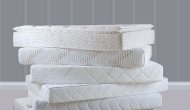Dust mites may be small and microscopic, but they can cause bigger problems such as allergies, itchiness, skin rashes, and asthma. These little critters can live in your mattress and bedding without you even knowing it! Fortunately for you and your family, there are simple ways to keep your bedding clean and prevent dust mites from making your mattress a permanent home. Read below for more information on dust mites, what they are, and how to keep them away for your health and peace of mind.
What are dust mites?
Dust mites are microscopic eight-legged critters that feed on dead skin cells from people and animals. They are everywhere and cannot easily be seen with the naked eye. These creatures prefer warm, moist places, which is why carpets and bedding are where they gravitate to most. They are common in most household settings and can multiply quickly with a fast reproductive cycle. Because dust mites do not burrow or bite humans, they mainly pose a risk when an individual is allergic or sensitive to their enzymes. This is where allergies, asthma, and difficulties breathing can arise.
Signs and Symptoms
While dust mites are usually difficult to detect, there are some physical signs and symptoms that can prove the presence of these critters in your home and on your bedding or mattress. These include:
- Coughing, runny nose, and sneezing
- A sore throat or wheezing
- Asthma symptoms
- Itchy and watery red eyes
- Rashes and eczema on the skin
Cleaning Your Mattress
If you notice that you may be hosting dust mites in your bed or even if you want to err on the side of caution, you should thoroughly clean your mattress as soon as possible. Remember to make a habit of it as well; you don’t want to only clean your mattress once and then feel like the job is done. Dust mites can be a recurring problem. Wash your bedding every week with laundry detergent and try to do so in high temperatures, which will ensure that no dust mites remain. Steam cleaning your bedding can also produce the same effect and remove dust mites efficiently. On the other side, covering your bedding and pillows and then putting them in the freezer for 48 hours will also remove dust mites, as they cannot survive in extreme temperatures. Since you can’t just throw your mattress in the laundry machine, you will have to clean it regularly with baking soda and a vacuum. Let the baking soda sit on top of the mattress for a few minutes before vacuuming it thoroughly. Use a vacuum with a HEPA filter that will get rid of dust mites and allergens.
Invest in a Mattress Cover
Now that you’ve thoroughly cleaned your mattress and bedding, you will want it to stay clean until the next time. Using a mattress cover over your mattress, you will have another protective layer so that cleaning up spills, dirt, and messes will be easier and faster. You will be able to clean the mattress cover more frequently, and it will protect the mattress from sweat, dirt, and bacteria becoming embedded in it. Choose a plastic, hypoallergenic mattress cover for ultimate protection and cleanliness.
Choose the Right Mattress
Fortunately, there are mattresses out there that are more resistant to allergens and dust mites than others. For example, latex mattresses naturally repel dust mites as they are made of sap from the rubber tree, which is a hostile environment for these critters. If you suffer from allergies and getting rid of dust mites is a top priority, a latex mattress will provide the hygienic sleeping conditions you are looking for to relieve allergies and symptoms of dust mites. Latex mattresses are also beneficial because they are breathable and can help prevent sweating for people who get too hot during the night.
Air Purifiers
Dehumidifiers and air purifiers work to help eliminate and prevent dust mites because they thrive in humid conditions. Removing these conditions and purifying the air around you can remove unwanted dust mites and allergens. You will also get the added benefit of breathing cleaner air with less pet dander, contaminants, mould, and other potentially dangerous particles.
Throw Out Old Bedding
It’s essential to get rid of old bedding, sheets, pillows, and mattresses that might harbour dust mites and other contaminants. Even old carpets, upholstery, and fabrics should be replaced as they can host dust mites and trigger allergies and asthma.
Now that you know exactly what dust mites are and how to prevent them, you can start making the right decisions for your health and sleep quality. Investing in a hypoallergenic or latex mattress, using a protective mattress cover, and keeping your room clean are all steps in the right direction to becoming free of pesky dust mites and creepy crawlies. For more information on hypoallergenic mattresses and the Sealy mattress sale in Toronto, please call Mattressville at 905-212-7722 or contact us here.










